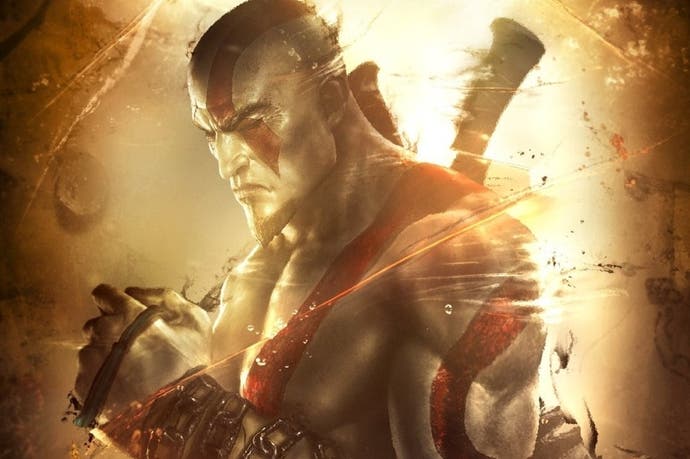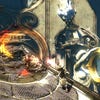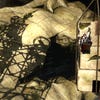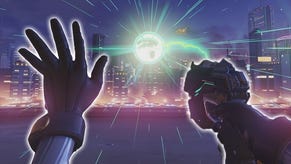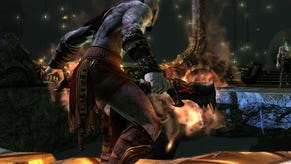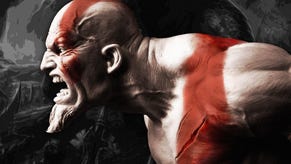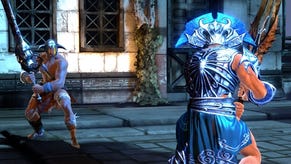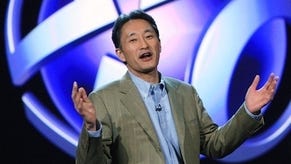Digital Foundry vs. God of War: Ascension
Divine.
With the next generation of consoles looming large, have we actually seen all there is to see on current-gen hardware? Are any further technological advances subject to the law of diminishing returns? Will further innovations be hamstrung by depressed performance, as we've seen recently in titles like Crysis 3 and Far Cry 3? Whatever else we see, if there's one team out there that can buck the trend, it's Sony Santa Monica. After all, that's exactly what it did on PlayStation 2.
Historically, the twilight years of a console are often the most prolific for bringing out the technical big guns, and God of War 2 stands tall alongside the likes of Shadow of the Colossus, Donkey Kong Country, Perfect Dark and Vagrant Story as latter-day titles which pushed the host hardware beyond its perceived limits. For PlayStation 3 in 2013, Sony - much more than its major rival - is looking to continue that tradition with Quantic Dream and Naughty Dog busy devising their own virtual swan-songs for the platform, and Sony Santa Monica taking point with a brand new God of War outing.
The thing is, breaking new technological barriers is a really tough call this time around. In the post-Uncharted 2 era, 2010's God of War 3 cemented Sony first-party's reputation for the most technologically advanced, visually breathtaking platform exclusives available on any home console. It remains a riotous celebration of an era where the true potential of the PS3's hardware was finally tapped. The first 30 minutes was game-changing stuff - a technical and artistic achievement that reset our expectations for what current-gen hardware was capable of. In that magical, jaw-dropping first half-hour, it was almost as though Sony Santa Monica had somehow software-injected a next-generation PlayStation into the current hardware.
The scale and speed of technological progression in that remarkable era was best summed up when we compared God of War 3's 2011 E3 demo with the final game. The results were revelatory: we saw the addition of full-screen and per-object motion blur, morphological anti-aliasing (MLAA), extra detailing, and revamped, substantially improved lighting. Despite such a radical overhaul, there was no hit to performance. Indeed, frame-rates actually increased substantially by anything up to 50 per cent with the Sony Santa Monica tech team optimising the game right up to the wire.
Three years have passed and new milestones in PS3 development are few and far between, so we were curious to see the extent to which Sony Santa Monica could improve and optimise its new game between demo and final release. To put this achievement into perspective, we juxtaposed the improvements with a similar comparison between the God of War 3 demo and its retail debut.
"Three years have passed and new milestones in PS3 development are few and far between - could anything Sony Santa Monica have produced have the same kind of impact that GOW3 did way back in 2010?"
On a technical level it's clear that Ascension offers nothing quite as revolutionary as the mix-up we see between God of War 3 and its demo, though plenty of changes have made their way in. The two biggest optimisations made are to texture streaming and frame-rate. The clay-like surfaces on walls in the demo now successfully swap out for higher-quality assets - it's a seamless transition that occurs within a split second, and by the same logic the shadow pop-in that was once a factor at the edges of the screen is no longer an issue. Crucially, however, this sharper level of detail extends to Kratos' body, revealing dirt marks and bump-mapped scarring, and the same applies to the surrounding cast of enemies.
It's a huge improvement that mirrors the texture quality boost of the last game, from pre-release to full, though changes in other areas are slight at best. Per-object motion blur remains as effective as before, and once again a form of edge-detection is on show, with a pixel-crawl that suggests a post-process technique such as MLAA is at play. Meanwhile, lighting is only barely adjusted this time. The biggest change is to the directional lighting from the sun, causing shadows to simply fall at a wider angle - a small tweak, and nothing close to the radical changes made to lighting in God of War 3.
Optimisation stands as a major breakthrough though, and seeing as it's not immediately evident where the gains have been made behind-the-scenes, it's commendable that we're seeing a consistent 5FPS improvement over the demo with no impairment to image quality. Be that as it may, the theory that technical advances are slowing in this regard does hold water when compared with God of War 3, which improved its frame-rate over the demo by as much as 15FPS in like-for-like sequences, and even more during battle. In the end, however, we're left with very similar playing fields in each final product; both games runs triple-buffered with an unlocked frame-rate, often giving way to wild fluctuations from 30FPS up to a juddering 45FPS.

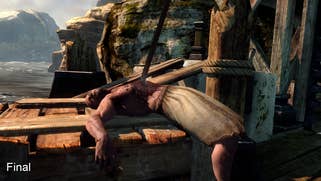
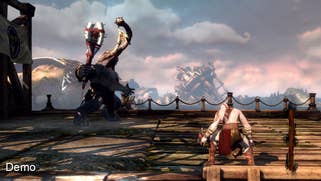


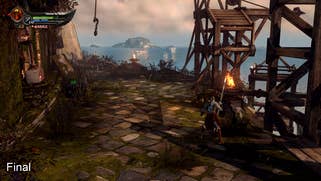
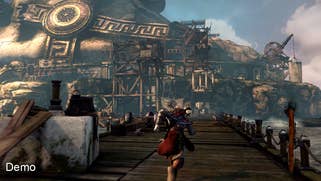



God of War: Ascension - the full game explored
However, this only gives us a limited, nine-minute window to view what Ascension brings to the table. The full adventure draws us away from the Island of Delos and towards the most varied range of locales yet seen in a God of War game. Environmental detail is striking, especially at the fixed vantage the camera keeps, with the world appearing less polygonal in nature thanks to the push for architecture based on giant effigies of Spartan gods, titans, and even serpentine shuttles. An increase in foliage helps embellish these structures, too, many of which are decorated with more destructible objects plus more convincing normal maps for cracks and creases on scenery. The opening city of Hecatonchires makes the biggest effort to show all these extra layers of detail off, with the titular titan at its centre wrenching and rotating chunks of the city, with Kratos battling away inside.
The stripping down and ruining of the city plays out brilliantly, pushing the illusion that anything in the world is malleable, though it's at these spectacular moments that we're reminded of the series' camera issues. Just as with the last game's battle with Poseidon, the point of view is very much set on framing this bigger, epic picture, and often winds up leaving Kratos standing just a few pixels tall - a priority of cinematic and technical flair over player agency that grates a little for those taking the combat seriously. Looking to the series' future, a boost to native 1080p would be a healthy and feasible step for tracking the finer details of these battles, but in the here and now a native 720p remains a superb achievement bearing in mind the level of technical accomplishment throughout the presentation.
This giant scale of destruction also scales down to Kratos' level, where the physics engine gets a far better stretch of its legs than before. Destructible, orb-yielding objects are now spread more liberally across the landscapes, with some structures needing to be struck down before a pathway opens up. The Amulet of Uroboros takes centre stage in many of the game's physics-based puzzles, allowing a player to dismantle or heal crumbling buildings to varying degrees, permitting a chance to shift other objects around mid-animation. This ability translates to combat, too; stopping an enemy's animation mid-air opens up an interesting range of attack possibilities, with one new addition being the ability to tether your chain to any enemy.
"Side by side with GOW3, the visual improvements are vast - we're looking at substantial boosts to lighting, physics, animation, and a radical overhaul to the visual effects pipeline."
Character animation receives special attention, too, with the inverse kinematic blending now a deciding factor in how characters move during both single and multiplayer. In essence, this weighs up the positions of each joint on a character model to determine where the soles of each foot should land while running, and how a weapon should be held given the stretch limits of each joint. The benefits of this approach work in favour of the studio's penchant for cinematic visuals, with this system doing a better job of avoiding collision - unintended overlaps in geometry - than purely scripted animations might do.
As the game progresses, we see more and more alpha and particle effects being added to the game's visual gamut. Kratos now has the freedom to switch between four elements mid-combo, including lightning, ice and fire and a purple miasma; each unlock in sequence, and each leaves residual traces of their effect on enemies after the strike. Once again, the action is difficult to read once the Rage meter builds to its peak, amplifying an already feverish maelstrom of explosions, blood splatters, floating health orbs, and collision sparks - in-between the chaos, we're often hoping the leading man is lurking somewhere unscathed. In any other action series, Kratos might find himself highlighted by a coloured contour to distinguish himself from the rabble of enemies, but this game-like convention could diminish the hard work put into God of War's filmic design.
It's eye candy nevertheless, and in concert with the new animation systems and heightened environmental detail, marks a clear advance over the effects-work seen in God of War 3. The question remains, however, whether these boons on the visual end come with any penalties to performance. Impressively enough, when putting the game through its paces in its latter half, after which most abilities have been unlocked, performance figures hold level with the circa 40FPS recorded around the Island of Delos. It's at its choppiest during the newly-added interactive finishers, where a tussle with a lashing Gorgon causes sharp dips to 20FPS, timed to every one of its red petrifying blasts. It's a rare drop, and a curious one too considering the alpha and lighting in use here aren't far beyond the levels we see during more freeform play.
"The developers have stuck to their triple-buffered unlocked frame-rate, meaning large variances in performance and some noticeable judder mitigated to a certain degree by the superb motion blur."
The key ingredient to presenting Ascension's vistas is in its careful management of lighting. There's an appreciated subtlety to the way ambient lights, such as lanterns in temples, spread outwards to eke out the most detail possible without over-saturating an indoor scene. Outside, directional lighting gives a more intuitive sense of progress, as dusk slowly turns to day over the course of our travels from shrine to shrine. The sun's position is usually low-key, creating an eye-catching balance between light and shade when the environment shifts around Kratos - one stand-out moment involving travel on the backs of giant serpents shows this off beautifully, as it winds around temples and caverns.
The complexity of geometry during this particular set-piece is surprising given the enormity of its scale, and how fast we're being shuttled around the Delphi temple and nearby caverns. To lighten the burden, instancing is used on each segment of the serpent - a cost-saving manoeuvre that duplicates the geometric data comprising each portion of its length, the order of which is then randomised to hide the fact. Even with this workaround (sparing a huge load on the PS3's 256MB pool of dedicated graphics RAM) it remains convincingly hidden and very much a worthwhile trade-off to have it running in-engine.
Much of the legwork is done on the fly, then, but Ascension has reason to reach for the pre-rendered content on the disc. Video sequences are typically used in a sparing fashion at the start of each chapter in a similar vein to the Uncharted series, where the goal is to avoid any visible break in action when transitioning between areas. The lack of any loading screens from start to finish does much to bolster the game's claim to being one of the most cinematic action titles available, and it's often impossible to tell actual in-engine gameplay from the video content - a trick Sony Santa Monica mastered in God of War 3. Each scene is brief, and the encoding quality is generally high enough to sidestep compression artifacting, though it can barely be distinguished by the superior treatment of aliasing, plus the firm lock to 30FPS that's missing in-game.
Multiplayer matters
As a surprise statement of intent, Sony Santa Monica led Ascension's unveiling by showing off the multiplayer mode, prompting some to believe it would be the competitive off-shoot of the series. Thankfully this wasn't precisely the case, and we've ended up with a very well-rounded package overall - though this does shine a light on how seriously the studio took the challenge of bringing God of War's narrative hooks into an online arena. In truth, there aren't many stages in rotation, but the organic, densely detailed approach to their layout clearly shows a firm belief in quality over quantity. The poster child for the mode is undoubtedly the chained "Megalops" titan, lauding over the upper levels of the Desert of Lost Souls stage like a grotesque theme park attraction - but with a design that's every bit in-keeping with the tone of the single-player game.
While Kratos is too big a fish for this particular pond, his rig is used for the thousands of nameless, customisable soldiers that walk in his stead, with animation necessarily hinging around longer attack build-ups to make moves readable by an opponent. The benefits of slowing down combat are obvious: a longer lead-in before the animation's concluding blow makes life easier for the net-code to resolve encounters.
"Animation hinges around longer attack build-ups to make moves readable by an opponent and makes life easier for the net-code to resolve encounters."
In many cases, the system needs to determine which of two duelling players is set to land the first hit. Presuming a latency of up to 150ms between systems, there's enough time within these new build-up animations to relay an outcome in advance to both consoles, creating the appearance of a jitter-free strike. The other benefit to slower attack wind-ups (plus the cooldown timers on magic) is that, among the eight concurrent players, there's only likely to be so many performance-sapping alpha effects on-screen at once; after all, each warrior should ideally be conserving them for the ideal moment to break an opponent's line of attack.
On the point of performance, frame-rate wavers between the 30 and 40FPS we're familiar with from single-player, regardless of the map chosen. The Labyrinth of Daedalus stage is the only exception to this rule; a dimly lit enclosure with a line of prison cells dangling by chains in its centre, which stays at a consistent low of 25FPS on the lower levels. This sustained rate owes itself to the hazardous traps in position here, spewing massive volumes of fire while combatants scramble to steer clear of each prison block's shifting edges. Aesthetically, the back-lighting is striking, with a single crack in the wall casting a low spread of light across the top layers, while players need to rely on ambient lighting from torches to see the front-facing segments. It's a real looker, and ambitious without the need for titans to have an influence on the stage.
God of War: Ascension - the Digital Foundry verdict
All in all, it's fair to say we've had more fun with Sony Santa Monica's multiplayer mode than its solo campaign - and for a number of reasons. Chief among them is that, perhaps inevitably, after five outings with Kratos these giant set-piece moments simply don't quite scratch the itch that they once did. Ultimately, we were keen to see the game's combat mechanics freed from its cinematic ambition which so often dominates the solo experience and this new competitive angle brings that out fully.
"The law of diminishing returns kicks in on the single-player game... but this doesn't detract from the scale of the technical achievement on offer throughout the entire Ascension package"
While there's a definite sense that the law of diminishing returns is kicking in on the single-player game from a conceptual standpoint, this doesn't detract from the scale of the technical achievement on offer throughout the entire package. For anyone looking to see what the PS3 hardware is truly capable of when pushed to its limits, this ranks as one of the most exceptional technical achievements of the current-gen era, convincingly up to the standards set by the likes of Uncharted 3 or Halo 4.
Side by side with God of War 3, the visuals improvements are vast - we're looking at substantial enhancements to lighting, physics, animation, and a radical overhaul to the effects pipeline, all of which serve to frame some spectacular action. The battles with titans such as Hecatonchires are stand-out, making for some of better roller-coaster rides we've seen from the series thus far. The only issue holding the experience back from true cinematic polish in our minds is the sound design, which has effects regularly losing sync during cut-scenes. It's strange to see such an oversight given the quality of the visual component, and this will hopefully be nipped by a future patch.
So, years from now, will we be looking back at God of War: Ascension as one of those key video games that defied the technical limitations of the host platform? From a technological standpoint, while its enhancements are legion, the game never astonishes in the same way that God of War 3 did in its opening levels. That perfect, brilliant melding of ambitious concept and technological execution and the sense that we were seeing something truly new and exciting just isn't quite there. But in the here and now, as a standard bearer for the state-of-the-art in PS3 tech, Ascension takes some beating.
